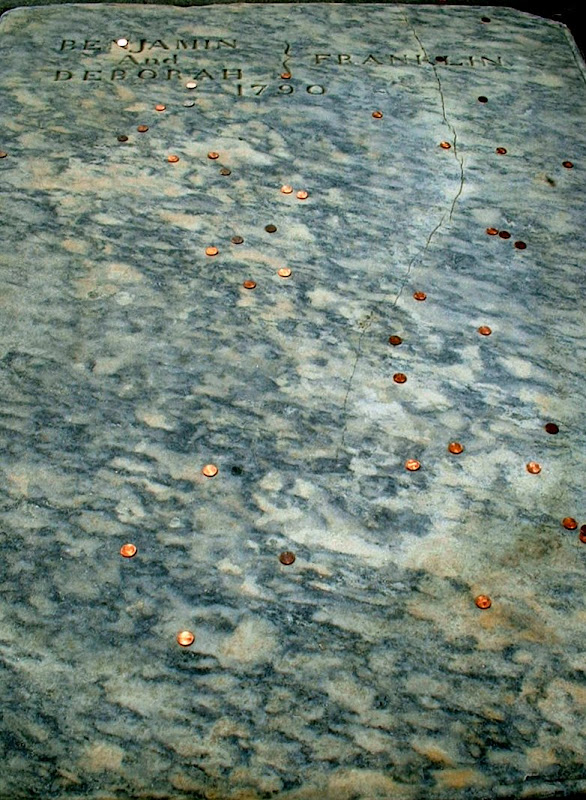AT FRANKLIN'S GRAVE
There is little to see at the grave itself.
Yet this doesn't mean one should not
Make the pilgrimage, only mend expectations.
Here is the trunk of a 1000 year-old red wood
called Benjamin Franklin.
The spirit of the tree remains.
So look up, not down at the dirty stone.
One shady tree covers a city block;
One B. Franklin button is a Continental souvenir.
Today the school children are milling about
On the sidewalk and curb in front of the gravestone
Of Franklin and his wife Deborah.
They form a single line at the edge
of their field trip.
The school children pitch pennies onto the slab.
The granite-veined grave is flat
and otherwise flat except
For a considerable crack—
The school children are pointing their fingers
at the crack&mdash "Two people, one stone,"
The school children can speak.
There is also a feather and that invisible dirt
they cannot live without.
Nothing has yet to be said of bricks.
Locked out of the graveyard
The school children stare,
With all their eyes and cameras—
They stare out across the street
to the Mint Building.
The entire scene has a certain feeling
of required reading and staring.
The school children are acting
As if they were still in school and still children,
which they are.
The 'role' of the school children is not the problem.
Only a thinness, or how small they can seem.
They stand-in for They.
Whether the ritual is like this because it's happening
At the edge of a chained-up graveyard,
Or because it's at the sleepy corner of an old city street,
there is no indication.
The dead tell us what they want us to know.
In Franklin's case it's still no dice,
only more silence.
Sirens are blaring from blocks away
And the cooling and heating systems
Are cooling and heating all around
on the tops of the buildings&mdash
The sound and sense of steam that follows steam.
The school children move in the shade of the afternoon
Shade that is also moving.
They stop, stand still, and never align.
No one is the wiser.
The shade being shade, coolly continues.
This is the nascent shade of a body,
Ravenous and blue. Grades of shades
Move like a library of school children,
Or one from the past. Their organizing principle
Involves well-designed sneakers
And the gratifying marks on a door frame—
How tall the school children will stand.
A line on the frame of a door,
Dates and lines on the molding.
The shade is no door, it is a shade
In a room with a door that inhabits the room
Like a story of a ghost: pleasing, bad,
Classical, wild— the school children demand
a ghost story.
And so the school children are accomplished
At the level of their own facts.
Year after year, they are measured:
This line is you; this line was you; these lines are you.
The dead tell us what we want them to tell us.
The dead tell us what they want us to know.
This was the invention of dialogue.
By THOMAS DEVANEY
